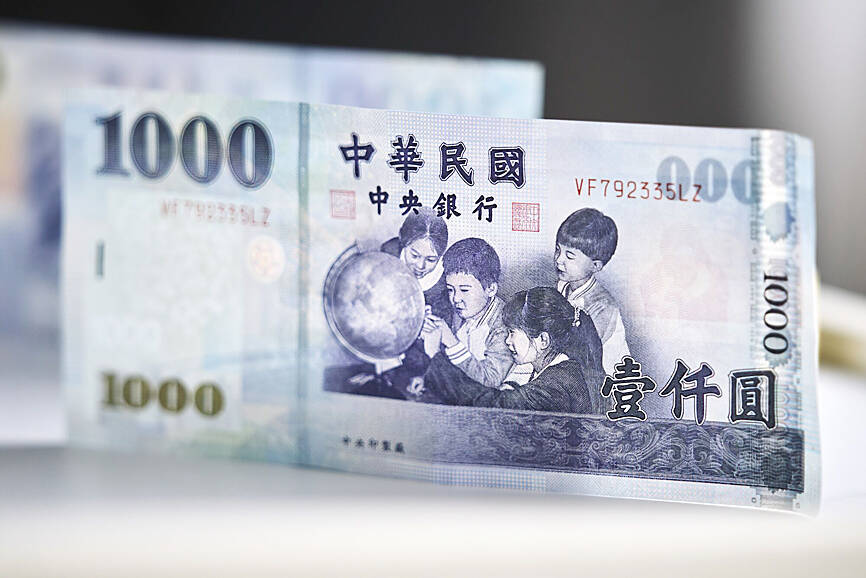The New Taiwan dollar’s rally is boxing in the central bank, leaving it with limited room to intervene to avoid a “currency manipulator” label from the US.
Heavy intervention in the first half of the year leaves the central bank with a buffer of US$4.5 billion for the second half, Bloomberg said. That is based on US Department of the Treasury criteria that net purchases of foreign currency in interventions should be below 2 percent of GDP over 12 months.
A smaller intervention cushion poses a challenge for the central bank, with the NT dollar forecast to rally further by about 2 percent this quarter as the artificial intelligence (AI) boom drives up demand for local semiconductors. Constraints on intervention would put investors on alert for abrupt moves such as the one in May when the local currency surged the most since the 1980s.

Photo: Bloomberg
Breaching US Treasury criteria risks putting Taiwan in the crosshairs of US authorities and could lead to unfavorable outcomes for the nation in trade negotiations. Some analysts expect the central bank to use interventions sparingly into the end of the year.
“Taiwan’s central bank would need to be more selective in when to step into the market and how much it intervenes to smooth out volatility,” Australia and New Zealand Banking Group Ltd head of Asia research Khoon Goh (吳昆) said. “As a result, we could see greater fluctuations in the Taiwan dollar for the rest of the year.”
The NT dollar has risen more than 6 percent so far this year to 30.75 per US dollar, and a Bloomberg survey showed it might advance further to 30.2 this quarter. The central bank already bought US$13.25 billion of US currency to cap the local currency’s gains from January to June, the most for a half year period since 2020.
Although its dollar purchases for the next US Treasury review that cover the 12 months through June are below the US threshold, the central bank would need to rein in further operations this year to avoid the manipulator label. The previous US report showed Taiwan on the list of countries that the US Treasury is closely monitoring.
The US dollar’s decline this year amid US fiscal concerns is boosting major Asian currencies, providing another tailwind for the NT dollar.
“Should Japanese yen and the Chinese yuan continue to strengthen, there could also be more room for Taiwan dollar to gain,” Malayan Banking Berhad senior foreign exchange analyst Fiona Lim said.
One option for the central bank to avoid the ire of US authorities is to influence the exchange rate.
In June, the central bank asked lenders to delay US dollar sales from exporters in a rare move, people familiar with the matter had said.
Investors are likely to keep a close watch on Taiwan’s trade data on Friday after exports to the US rose sharply in September despite tariffs. Another stellar month would boost the market’s confidence in the local economy and lay the ground for a stronger NT dollar.
“This makes the central bank’s job more challenging amid the presence of the Treasury Report, which acts as a hindrance to the [central bank’s] intervention efforts,” Lim said.

RUN IT BACK: A succesful first project working with hyperscalers to design chips encouraged MediaTek to start a second project, aiming to hit stride in 2028 MediaTek Inc (聯發科), the world’s biggest smartphone chip supplier, yesterday said it is engaging a second hyperscaler to help design artificial intelligence (AI) accelerators used in data centers following a similar project expected to generate revenue streams soon. The first AI accelerator project is to bring in US$1 billion revenue next year and several billion US dollars more in 2027, MediaTek chief executive officer Rick Tsai (蔡力行) told a virtual investor conference yesterday. The second AI accelerator project is expected to contribute to revenue beginning in 2028, Tsai said. MediaTek yesterday raised its revenue forecast for the global AI accelerator used

Taiwan Semiconductor Manufacturing Co (TSMC, 台積電) has secured three construction permits for its plan to build a state-of-the-art A14 wafer fab in Taichung, and is likely to start construction soon, the Central Taiwan Science Park Bureau said yesterday. Speaking with CNA, Wang Chun-chieh (王俊傑), deputy director general of the science park bureau, said the world’s largest contract chipmaker has received three construction permits — one to build a fab to roll out sophisticated chips, another to build a central utility plant to provide water and electricity for the facility and the other to build three office buildings. With the three permits, TSMC

The DBS Foundation yesterday announced the launch of two flagship programs, “Silver Motion” and “Happier Caregiver, Healthier Seniors,” in partnership with CCILU Ltd, Hondao Senior Citizens’ Welfare Foundation and the Garden of Hope Foundation to help Taiwan face the challenges of a rapidly aging population. The foundation said it would invest S$4.91 million (US$3.8 million) over three years to foster inclusion and resilience in an aging society. “Aging may bring challenges, but it also brings opportunities. With many Asian markets rapidly becoming super-aged, the DBS Foundation is working with a regional ecosystem of like-minded partners across the private, public and people sectors

BREAKTHROUGH TECH: Powertech expects its fan-out PLP system to become mainstream, saying it can offer three-times greater production throughput Chip packaging service provider Powertech Technology Inc (力成科技) plans to more than double its capital expenditures next year to more than NT$40 billion (US$1.31 billion) as demand for its new panel-level packaging (PLP) technology, primarily used in chips for artificial intelligence (AI) applications, has greatly exceeded what it can supply. A significant portion of the budget, about US$1 billion, would be earmarked for fan-out PLP technology, Powertech told investors yesterday. Its heavy investment in fan-out PLP technology over the past 10 years is expected to bear fruit in 2027 after the technology enters volume production, it said, adding that the tech would